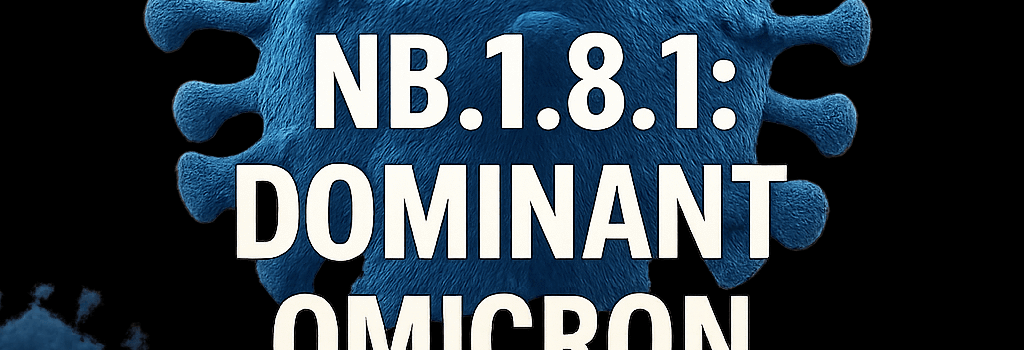NB.1.8.1: Dominant Omicron Subvariant in the US and Its Implications

Although overall COVID-19 transmission in the United States remains at historically low levels, virologists and public health experts are raising alarms about the rapid proliferation of a new SARS-CoV-2 subvariant, NB.1.8.1. This omicron descendant, first flagged in parts of Asia, carries a suite of spike protein mutations that enhance both ACE2 receptor binding affinity and partial immune escape. Coupled with waning population immunity after a quiet winter, these factors set the stage for a potential summer wave.
Lineage, Key Spike Mutations, and Infectivity Advantage
NB.1.8.1 is derived from the recombinant XDV.1.5.1 lineage. Compared to its closest omicron relatives (JN.1 and LP.8.1), NB.1.8.1 harbors several notable spike mutations:
- R346T – located in the receptor‐binding domain (RBD), linked to reduced neutralization by class 3 monoclonal antibodies.
- F486S – also in the RBD, potentially increasing hydrophobic contacts with ACE2 and improving fusogenicity.
- N440K – associated with evasion of certain convalescent sera and monoclonal therapies.
In vitro pseudovirus neutralization assays conducted at the National Institute of Allergy and Infectious Diseases (NIAID) report a 3- to 5-fold reduction in neutralizing antibody titers against NB.1.8.1 sera from triple-vaccinated individuals, compared with wild-type omicron strains. Meanwhile, basic reproduction number (R₀) estimates, based on genomic growth rate models, suggest a ~20% transmissibility advantage over LP.8.1.
Global and US Epidemiology
Following its initial surge in China, Hong Kong, Singapore, and Taiwan in late May, NB.1.8.1 has steadily increased its market share across sequencing surveillance networks. According to the latest CDC variant tracking report (June 30, 2025), NB.1.8.1 now comprises an estimated 45% of new COVID-19 cases in the US, up from 15% just three weeks prior. Its prevalence is climbing in all four Health and Human Services (HHS) regions, with the highest concentration in the Northeast and Mid-Atlantic.
“We are observing a clear growth advantage for NB.1.8.1, consistent with both lab and field data,” says Dr. Maria Riley, a genomic epidemiologist at Johns Hopkins University. “If this trajectory continues, we could see case numbers double within the next month in the absence of strengthened mitigation measures.”
Simultaneously, the European Centre for Disease Prevention and Control (ECDC) warns of a gradual summer uptick across the EU/EEA, citing partially waned immunity among older adults and higher-risk populations.
Molecular Insights into NB.1.8.1 Fitness
High-resolution cryo-electron microscopy studies show that the F486S substitution reorients a hydrophobic patch in the RBD, lowering the dissociation constant (Kd) for human ACE2 by roughly 1.5-fold. Computational molecular dynamics simulations corroborate these findings, indicating increased stability of the RBD–ACE2 complex under physiological conditions (37°C, pH 7.4). Additionally, glycan shield remodeling—through an adjacent N-linked glycosylation site shift—may further mask key neutralizing epitopes.
Vaccine Efficacy and Booster Strategy Implications
Current bivalent mRNA boosters (targeting ancestral and BA.4/BA.5 spikes) continue to offer robust protection against severe disease, with real-world effectiveness studies showing ~85% efficacy in preventing hospitalization. However, neutralization titers against NB.1.8.1 are reduced by ~4-fold compared to BA.5. Leading vaccine manufacturers, including Pfizer-BioNTech and Moderna, have already initiated preclinical development of next-generation mRNA constructs specifically incorporating NB.1.8.1 spike sequences.
“An updated booster — potentially a trivalent formulation including NB.1.8.1 — would restore neutralization breadth and counterbalance immune imprinting,” explains Dr. Joseph Kim, head of viral immunology at Moderna.
Genomic Surveillance, Public Health Response, and Policy Challenges
Real-time surveillance platforms, such as GISAID and CDC’s BioFire Trend, are critical for tracking NB.1.8.1’s spread and mutation emergence. Yet budget cuts and staffing changes at federal agencies threaten data timeliness. The recent resignation of a senior CDC vaccine policy analyst has fueled concerns about the objectivity of forthcoming recommendations.
CDC ACIP Meeting and Policy Shifts
From June 25–27, the CDC’s Advisory Committee on Immunization Practices (ACIP) convened to vote on fall COVID-19 booster guidelines. In a highly publicized move, all 17 previous voting members were replaced by appointees with documented antivaccine positions, raising alarms over potential delays in booster rollout for pregnant individuals, immunocompromised patients, and healthy adults under 65.
Expert Recommendations
- Accelerate deployment of NB.1.8.1-tailored mRNA boosters, prioritizing high-risk cohorts.
- Increase sequencing capacity to at least 10,000 genomes per week nationwide.
- Reinstate transparent, evidence-driven decision-making processes within federal health agencies.
Outlook for the Summer Wave
With NB.1.8.1 on track to outcompete existing omicron subvariants and immunity waning, models project a 15%–25% rise in weekly case counts by mid-July. Although severe disease rates are unlikely to exceed previous omicron waves, hospital systems in regions with low booster uptake may experience localized strain.
Bottom line: Vigilant genomic monitoring, rapid booster updates, and evidence-based policy will be key to mitigating NB.1.8.1’s impact on the US summer COVID-19 wave.